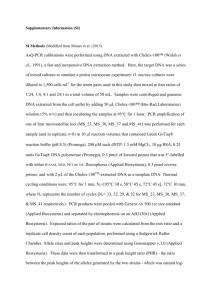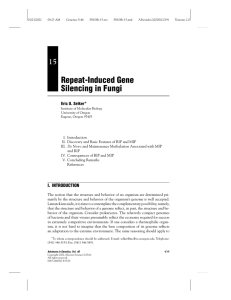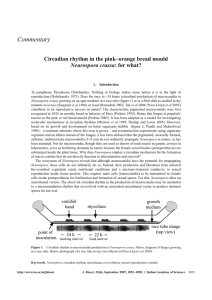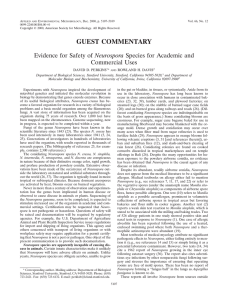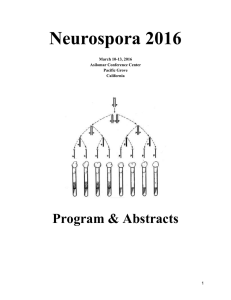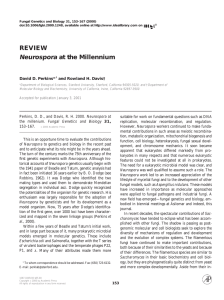Text S1. SUPPLEMENTAL EXPERMENTAL
advertisement
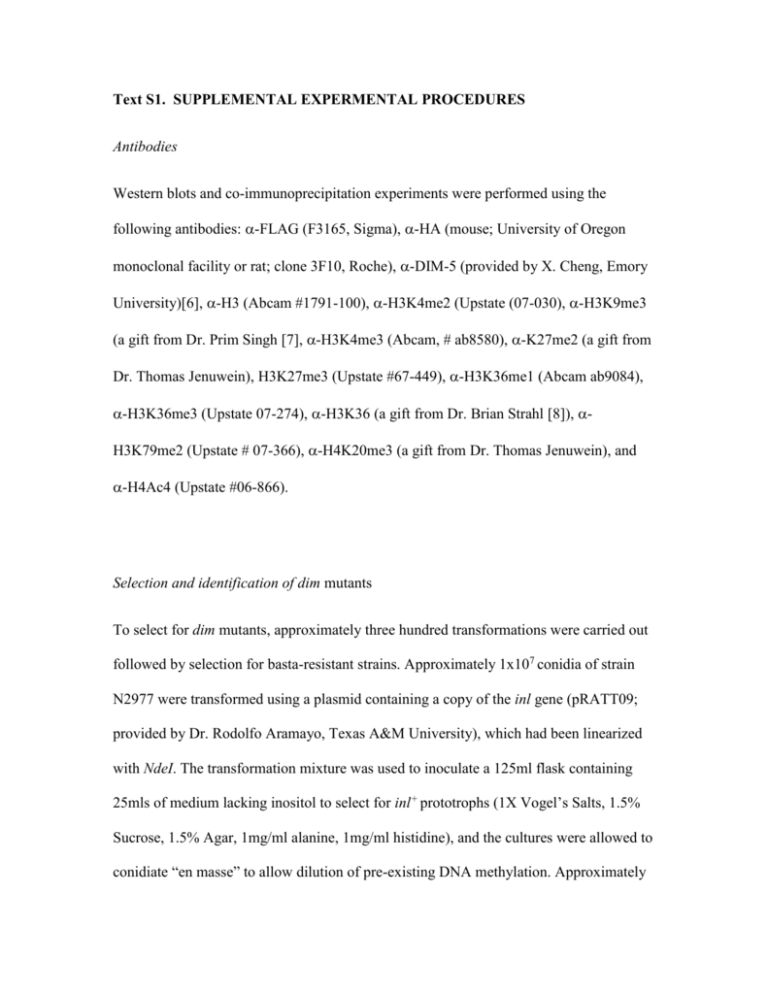
Text S1. SUPPLEMENTAL EXPERMENTAL PROCEDURES Antibodies Western blots and co-immunoprecipitation experiments were performed using the following antibodies: -FLAG (F3165, Sigma), -HA (mouse; University of Oregon monoclonal facility or rat; clone 3F10, Roche), -DIM-5 (provided by X. Cheng, Emory University)[6], -H3 (Abcam #1791-100), -H3K4me2 (Upstate (07-030), -H3K9me3 (a gift from Dr. Prim Singh [7], -H3K4me3 (Abcam, # ab8580), -K27me2 (a gift from Dr. Thomas Jenuwein), H3K27me3 (Upstate #67-449), -H3K36me1 (Abcam ab9084), -H3K36me3 (Upstate 07-274), -H3K36 (a gift from Dr. Brian Strahl [8]), H3K79me2 (Upstate # 07-366), -H4K20me3 (a gift from Dr. Thomas Jenuwein), and -H4Ac4 (Upstate #06-866). Selection and identification of dim mutants To select for dim mutants, approximately three hundred transformations were carried out followed by selection for basta-resistant strains. Approximately 1x107 conidia of strain N2977 were transformed using a plasmid containing a copy of the inl gene (pRATT09; provided by Dr. Rodolfo Aramayo, Texas A&M University), which had been linearized with NdeI. The transformation mixture was used to inoculate a 125ml flask containing 25mls of medium lacking inositol to select for inl+ prototrophs (1X Vogel’s Salts, 1.5% Sucrose, 1.5% Agar, 1mg/ml alanine, 1mg/ml histidine), and the cultures were allowed to conidiate “en masse” to allow dilution of pre-existing DNA methylation. Approximately 1x106 inl+ conidia from each transformation mixture were plated on medium containing basta [Vogel’s (-NH4NO3), 0.5% proline, 1.5% Agar, 50ng/ml inositol, 1mg/ml alanine, 1mg/ml histidine, 2% sorbose, 0.05% glucose, 0.05% fructose, 400mg/ml basta] [9] to select for strains that had reactivated the methylated bar gene. Basta-resistant colonies were isolated, transferred to slants containing 400µg/ml basta and tested for growth on 200µg/ml hygromycin. Strains that were resistant to both drugs were analyzed further. For the dim-8193-2 mutant, the integration site of the inl cassette was determined by inverse PCR. Genomic DNA was first digested with PstI, which cuts once within the pRATT09 plasmid. Digested DNA was then incubated with T4 DNA ligase (NEB) to generate circular ligation products. Following ligation, inverse PCR was performed using primers INL INV1 plus INL INV2, the ligation mixture as a template, and LA Taq polymerase (Takara) to generate a linear DNA fragment containing DNA from the insertion site. To identify the plasmid insertion site, DNA sequencing reactions were performed using the linear PCR product as a template and the BLA EXT primer. Although the insertion cassette and the Dim- phenotype of dim-9 strains were genetically separable, analyses of progeny from a backcross revealed that the insertion cassette and dim-9227-2 were linked, residing ~2 map units apart. We used plasmid rescue to determine that the insertion cassette had integrated on LGII. Genomic DNA was digested with EcoRI, which does not cut within the pRATT09 insertional vector. Digested DNA was then incubated with T4 DNA ligase (NEB) to generate circular ligation products and ligation mixtures were transformed into E. coli to obtain ampicillinresistant colonies. We next sequenced across the NdeI site to identify the insertion site using Rescue FP and Rescue RP primers. Generation and complementation of cul-4RIP1 The cul-4+ gene (NCU00272.2), with its native promoter and the downstream regions, were amplified using primers 2206 and 2209 from cosmid pMOcosX5E8 [10]. The PCR product was cloned between the SpeI and EcoRI sites of pBM61 to generate pKA67. This plasmid was digested with DraIII and integrated into the his-3 locus of strains N623 and N3016 [11]. Two His+ transformants of opposite mating types, each containing a duplication of cul-4 gene, were then crossed to each other to induce RIP. Six slow growing and sparsely conidiating progeny were selected for further analysis as putative cul4 mutants. Analysis of the cul-4 gene from these strains by PCR-RFLP using the restriction enzyme MseI revealed evidence of extensive mutations by RIP. One of these strains was further crossed to a his-3 strain (N3016) to obtain strain N3892, which lacks the duplication. DNA sequencing (primers 2195-2201) of the cul4 allele (cul-4RIP1) amplified (primers 2206 & 2209) from this strain revealed numerous premature termination codons and other mutations. To test for complementation of cul-4RIP1 with the wildtype allele, plasmid pKA67 was digested with DraI and introduced into the his-3 locus of strain N3892 by transformation. Two His+ transformants (N3893 and N3894) that displayed complementation of DNA methylation (data not shown) were selected for study. Cul-4 constructs To purify proteins associated with CUL-4, we made a construct (pKA122) to express this protein with N-terminal tags consisting of Met-FLAG-HAT-3xFLAG and 5x-glycine spacers between the epitopes and between them and CUL-4. Because there was uncertainty about which methionine codon represented the actual start of the protein, we transformed strain N3892 with four constructs to test the function of four potential start codons and tested the transformants for defects in DNA methylation. Methionines were labeled M1, M2, M3, and M4, based on the predicted amino acid sequence of the prediced protein encoded by NCU00272 (XP_957743.2). N-terminal, FLAG-tags introduced at methionine #1 (MPSNS), methionine #2 (MSAKL), and methionine #3 (MATGK) all complemented the DNA methylation defect, whereas an N-terminal, FLAG tag introduced at methionine #4 (MEKL) failed to restore DNA methylation in the cul4 mutant. DDB1 and DIM-9 knock-in strains Fragments of the DDB1 coding sequence and the DDB1 3’UTR were amplified with 6605 tag FP plus 6605 tag RP and 6605 tag UTR FP and 6605 tag UTR RP, respectively. Fragments of the DIM-9 coding sequence and the DIM-9 3’ UTR were amplified with 1656 tag FP plus 1656 tag RP and 1656 UTR tag FP plus 1656 UTR tag RP, respectively. Knock-in plasmids were assembled by yeast in vivo recombination with a 10XGly3XFLAG-hph fragment and pRS416 as described [12]. Southern blots were performed to verify that all knock-in constructs support wildtype levels of DNA methylation. H2A-GFP constructs To facilitate tracking chromatin cytologically, we engineered a GFP-tagged version of Neurospora crassa histone H2A. The hH2A gene (NCU02437.2), including its native promoter, was amplified from wildtype genomic DNA (strain N150) with primers 2388 and 2686 and cloned into the GFP-experssion vector, pCCG::C-Gly::GFP [12]. The resulting plasmid (pKA134) was digested with XmnI and integrated at the his-3 locus of various strains by electroporation to generate His+ transformants that express H2A-GFP in various genetic backgrounds (Table S3). To facilitate tracking chromatin cytologically, dilute conidial suspensions of wildtype and mutant strains expressing H2AGFP were spotted on agar medium (Vogel’s N medium containing 0.5% sucrose and supplemented with 0.2 mg/ml leucine and 0.01 mg/ml pantothenic acid) and incubated at 32C. Square pieces of agar with germinating conidia (after 2hrs of growth) or hyphae (after overnight growth) were cut with glass coverslips and placed on glass slides. These agar pieces were flooded with liquid Vogel’s N medium and covered with coverslips for visualization of H2A-GFP. REFERENCES 1. Lewis ZA, Adhvaryu KK, Honda S, Shiver AL, Selker EU (2010) Identification of DIM-7, a protein required to target the DIM-5 H3 methyltransferase to chromatin. Proc Natl Acad Sci U S A 107: 8310-8315. 2. Kouzminova EA, Selker EU (2001) Dim-2 encodes a DNA-methyltransferase responsible for all known cytosine methylation in Neurospora. EMBO Journal 20: 4309-4323. 3. Freitag M, Williams RL, Kothe GO, Selker EU (2002) A cytosine methyltransferase homologue is essential for repeat-induced point mutation in Neurospora crassa. Proc Natl Acad Sci U S A 99: 8802-8807. 4. Tamaru H, Selker EU (2001) A histone H3 methyltransferase controls DNA methylation in Neurospora crassa. Nature 414: 277-283. 5. Freitag M, Hickey PC, Khlafallah TK, Read ND, Selker EU (2004) HP1 is essential for DNA methylation in Neurospora. Mol Cell 13: 427-434. 6. Collins RE, Tachibana M, Tamaru H, Smith KM, Jia D, et al. (2005) In vitro and in vivo analyses of a Phe/Tyr switch controlling product specificity of histone lysine methyltransferases. J Biol Chem 280: 5563-5570. 7. Tamaru H, Zhang X, McMillen D, Singh PB, Nakayama J, et al. (2003) Trimethylated lysine 9 of histone H3 is a mark for DNA methylation in Neurospora crassa. Nat Genet 34: 75-79. 8. Adhvaryu KK, Morris SA, Strahl BD, Selker EU (2005) Methylation of Histone H3 Lysine 36 Is Required for Normal Development in Neurospora crassa. Eukaryot Cell 4: 1455-1464. 9. Pall ML (1993) The use of Ignite (Basta;glufosinate;phosphinothricin) to select transformants of bar-containing plasmids in Neurospora crassa. Fungal Genetics Newsletter 40: 58. 10. Orbach MJ (1994) A cosmid with a HyR marker for fungal library construction and screening. Gene 150: 159-162. 11. Margolin BS, Freitag M, Selker EU (1997) Improved plasmids for gene targeting at the his-3 locus of Neurospora crassa by electroporation. Fungal Genetics Newsletter 44: 34-36. 12. Honda S, Selker EU (2009) Tools for fungal proteomics: multifunctional neurospora vectors for gene replacement, protein expression and protein purification. Genetics 182: 11-23.






